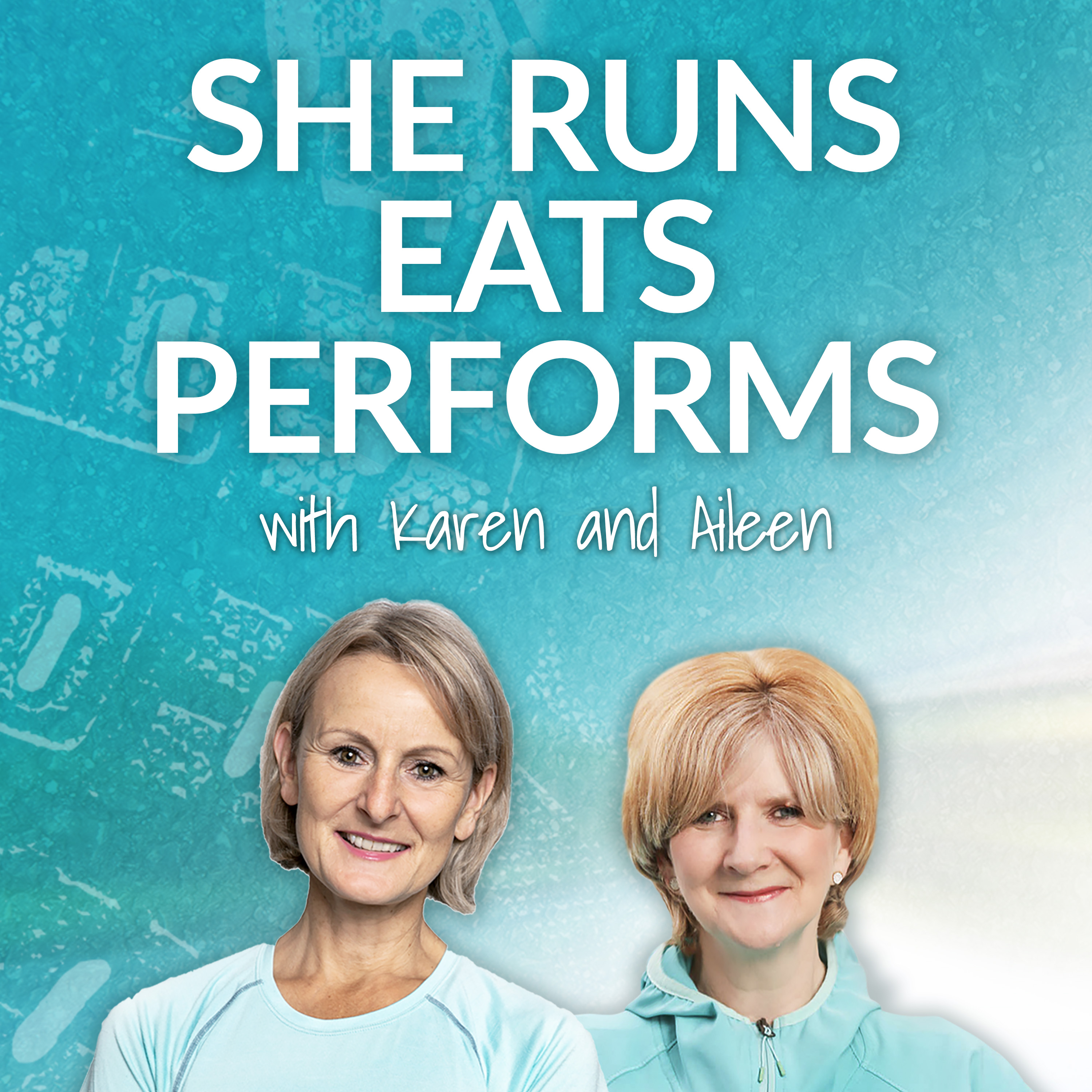Healthy Bones for Female Runners
Endurance Runners are at a high risk of Bone Stress Injuries. Being aware of the risk factors and having a strategy to help prevent bone stress injuries or fractures is vital.
Today we’ll share why being a runner puts you at risk, what key nutrients are vital for bone health and some training hacks to help you have good bone health and avoid an injury which may take you out of training for a long time!
Today we are going to talk about:
1. Why are endurance runners at risk of bone stress injuries
2. What are the key nutrients for bone building
3. How to approach your run training plan to promote healthy bones
SHOW NOTES
(02:41)
Why bone health is so important for mid-life female runners.
Endurance runners are at risk of bone stress injuries, and a high percentage of midlife females are also at less a risk of losing bone mineral density, which increases their risk of bone injuries.
(05:21)
Bone Stress Injuries – intrinsic and extrinsic risk factors
(06:08)
Underlying health factors for Bone Stress Injuries in runners may include:
- health conditions that reduce bone density (such as osteoporosis)
- poor nutrient status which underpins poor bone health
- prior stress injury to the bone
- training related– duration/distance/rest & recovery or perhaps poor biomechanics or running technique.
(07:48)
Bone re modelling and which groups of runners may be at risk of bone stress injuries due to their training approach:
· All year-round runners: the serious recreational runners, who run long distances week in and out, without rest days or scheduled rest weeks. So, there is the potential for repetitive over loading.
· Seasonal recreational runners: they take on a challenge and ramp up their training too quickly. Rapid increases in training loads may increase the risk of running injuries.
· Runners who ignore niggly injuries which develop into BSI’s. BSI’s typically occur 3-4 weeks after a major workload error – we may not even realise we have an injury or perhaps we ignore the niggly pain associated with it – so if we keep training and loading the bone we may be exacerbating the problem and slowing down the bone remodelling process.
(13:57)
Considerations about the bone remodelling timeline and how rest periods may help prevent excessive micro damage.
(20:52)
Nutrients to support bone building.
To support healthy bones, it’s key to a healthy body composition, eat enough for energy expenditure, and follow an anti-inflammatory food plan. Under eating or calorie restriction potentially down regulates IGF-1 (insulin like growth factor required) which is required or bone modelling. It’s also important to focus on the nutrient content of your food i.e. nutrient dense food containing bone building nutrients. Inflammation drives bone loss so following an anti-inflammatory food plan and being a healthy weight will both support a healthy inflammation status.
Bone building nutrients include Protein, Calcium, Magnesium, Vitamin K2, Vitamin and Collagen.
(25:38)
Protein
Protein stimulates IGF-1 growth factor, supplies essential amino acids for collagen production (bone matrix) and will also help build/repair lean muscle mass (key for weight management).
Post-menopausal protein requirements are 1.2g-1.6g protein/kg/body weight per day. You do not need to calculate/count protein but please ensure you eat adequate protein at every meal and snack. As a guide ¼ plate or palm sized portion at meals and half this amount at snacks. It’s best to spread you protein intake across the day so please don’t miss protein at any meal/snack.
(26:39)
Structural Bone Building Nutrients
Calcium is the nutrient most of us associate with bone health and mid-life women require 1200-1500 mg/day from food and supplements – worth bearing in mind that we typically absorb only 50% of calcium so ensuring you are consuming enough is vital. Calcium sources:
- Calcium: dairy, tinned fish with bones
- Calcium plant sources: green leafy vegetables, almonds and sesame seeds, dried fruit, pulses, fortified foods (e.g. plant milks, tofu), seaweeds
Magnesium supports the absorption of magnesium and food sources include wholegrains, nuts and seeds, pulses, leafy veg, cocoa/cacao
Vitamin K2 activates osteocalcin and directs calcium to the bones and away from soft tissue. Food sources include: liver, jarlsberg cheese, egg yolks, natto (Japanese fermented soy).
Vitamin D - it’s important to get your Vitamin D status tested for bone health.
- Vitamin D: sunlight, oily fish, egg yolk, mushrooms, fortified foods
Collagen is also important for the formation of bone matrix – we have an episode dedicated to collagen E 117
(32:14)
Consider booking a Personalised Supplement Review
(35:35)
How to approach your run training plan to promote healthy bones
(39:33)
How to promote mechano adaptation to support minimising BSI risks
Mechano adapation is defined as bone structure adaptation in response to physical stimuli such as exercise.
Bone responds best to high magnitude loads introduced at high rates.
Weight bearing activities including impulsive loading and some degree of intermittent, explosive jumping and/or sprinting with rapid changes in direction, have the greatest osteogenic (bone building) potential.
Distance running does not necessarily encourage stimulation of bone building cells. Continuous repetitive loading can lead to bone cells losing mechanosensitivity so they become deaf to stimuli from bone loading.
The implication is that after a few minutes of running, bone cells find the monotonous, unidirectional loading to be boring and they stop responding. So this isn’t good news for a distance runner who is running repetitive linear miles.
It means we can’t rely on distance running alone to support mechano adaptation for bone health, however there are things we can do:
· Having a rest period of 4-8 hours enables the system to regain mechanosensitivity and after that period, adding in a few minutes of bone-centric exercise (e.g. plyometrics) may generate further bone adaptation.
· Another consideration is using periodisation to promote mechanosensitivity. There was an animal study which compared 2 groups – one that received continuous loading for 15 weeks versus a periodized approach of two 5-week blocks separated by a 5-week ‘rest’ period. In a running scenario, clinically, “rest” would involve other conditioning activities (such as cycling, swimming, water running) that load alternate skeletal sites, so you would be changing activities rather than totally resting.
· Aiming to reduce your loading would be to consider adding in one or two treadmill training sessions per week as this may help lower tibial bone strain compared to overground training.
· Gait retraining may be helpful for runners with repeat BSIs and involves implementing techniques to reduce Ground Force Reaction (GRFs) and/or bone accelerations, there doesn’t seem to be a lot of evidence to support gait retraining but that doesn’t necessarily mean it isn’t supportive, so take advice from your physio.
(44:51)
One Key Action Point: Add some multi-directional/plyometric exercises into your weekly training plan whatever your distance and volume of training is.
Other Resources
Preventing bone stress injuries in runners with optimal workload
HEALTHY BONES HEALTHY YOU by Lara Pizzorno
(45:45)
Key Take Aways
1. It’s possible to minimise risks of BSI’s by considering extrinsic (being the load applied to the bone), and intrinsic factors (the strength of the bone which may be affected by nutritional status) and underlying health conditions).
2. Every runner should have at least 1 full rest day per week.
3. If you run 12 months of the year, consider adding 1 week of full rest every 3 months as a minimum.
4. If you are a seasonal runner, plan to start your training with a conditioning phase and carefully plan how your training progresses so you are not outing undue loading stress on your bones by training to hard, too fast or too long over a short period.
5. Every endurance runner would benefit by adding plyometric exercises into their weekly training plan – remember this includes weight bearing and multi directional activities including explosive jumping and sprinting with rapid directional changes.
6. Your food plan should include abundant sources of PROTEIN, Calcium, Magnesium, K2, Vitamin D, Collagen to promote bone building.
Related Topics:
Bone Health for Runners Part 1
Endurance Running and Immune System
Disclaimer:
The suggestions we make during this episode are for guidance and
advice only, and are not a substitute for medical advice or treatment.
If you have any concerns regarding your health, please contact
your healthcare professional for advice as soon as possible.
Aileen Smith and Karen Campbell host RUNNERS HEALTH HUB. A place for like-minded female runners who are looking for simple ways to support running performance, energy, endurance, and general great health.
if this is your first time your show and you’d like to know more about us and She Runs Eats Performs please check out our TRAILER.
If you're ready to make learn more about how you may introduce easy nutrition into your running and training plan join our Easy Nutrition For Healthy Runners Online Programme for short videos, recipes, downloads and LIVE training and Q&A.
As a THANK YOU to you as one of our valued listeners, we have a special offer for you use COUPON CODE POD to get 33% discount off the full price which brings the price to £199.
If you’d like help from Karen and Aileen to design a personalised sports nutrition plan for your running - please contact us at hello@runnershealthhub.com
Happy Running!
Aileen and Karen

